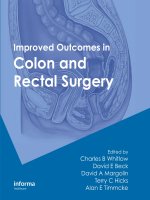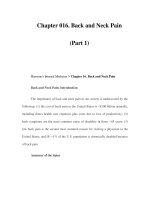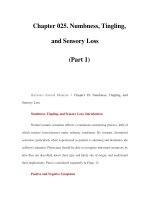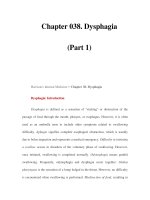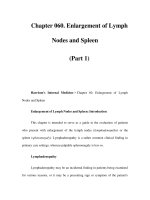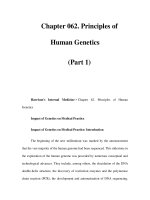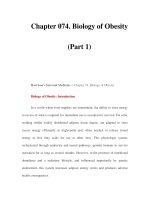Neurology 4 mrcp answers book - part 1 ppsx
Bạn đang xem bản rút gọn của tài liệu. Xem và tải ngay bản đầy đủ của tài liệu tại đây (205.45 KB, 14 trang )
Answers Book / Contents:
A total of 17 chapters containing 713 Answers
distributed as;
1- Cardiology; 55 answers.
2- Pulmonary medicine; 51 answers.
3- Gastroenterology; 50 answers.
4- Hepato-biliary system; 30 answers.
5- Nephrology; 51 answers.
6- Electrolytes and Acid-Base Disturbances; 20
answers.
7- Endocrinology; 50 answers.
8- Diabetes Mellitus; 20 answers.
9- Hematology; 40 answers.
10- Rheumatology; 50 answers.
11- Neurology; 176 answers.
12- Infectious diseases; 40 answers.
13- Immunology; 10 answers.
14- Psychiatry 10 answers.
15- Dermatology; 35 answers.
16- Genetics; 5 answers.
17- Toxicology; 20 answers.
NB: Questions regarding basic medical sciences are
distributed throughout chapters.
This is the Answers Book
Please see questions in the Question Book
Preface:
The art of medicine involves questions. It involves
questions asked when taking a medical history, when
forming a differential diagnosis, and when planning a
diagnostic or therapeutic plan. MRCP candidates,
regardless of their level of training, are constantly
confronted with questions posed from past papers, from
patients, from mentors, and from within themselves.
The time-honored, question-based, Socratic approach
of teaching is alive and well in academic and clinical
world of internal medicine. This book is intended to
provide the reader with many of the questions and
answers commonly encountered during their MRCP
study and period of preparation. This book is not meant
to replace textbooks. Rather it intended to focus on the
lead-in questions and topics commonly seen in the
MRCP examination. Please read textbooks to boost
your level of knowledge. Some of the 1
st
chapters were
launched in www.aippg.net
website; but these are now
modified and updated.
I'm greatly thankful to my direct board supervisor
Professor Doctor Khalil Al-Shaikhly (MRCP UK,
FRCP Glasgow) for his continuous support, to our dear
patients, and to my dear friends and colleagues.
Dr. Osama Amin
All Rights Reserved. January 2006.
/> />
Chapter I / Cardiology Answers
Q1:
Answer: e
All other options are true, and also: hypertrophic obstructive cardiomyopathy, and
right ventricular hypertrophy. Note that the causes are not that many and they are easy
to be remembered.
Remember: TRUE and isolated posterior wall MI is very rare, usually associated with
inferior wall myocardial infarction, so look also at lead II, III, and aVF (i.e. right
coronary artery occlusion).
NB: Mirror image dextrocardia and wrong lead connection (so called limb lead
reversal) are usually forgotten as a cause of prominent R wave in lead V1.
Q2:
Answer: e
All other options are associated with ST segment depression.
Causes of ST elevation:
A- Full thickness myocardial infarction ( so called ST segment elevation myocardial
infarction or STEMI).
B- Early repolarization after an attack of angina.
C- Acute pericarditis.
D- Ventricular aneurysm.
E- Transiently during cardiac and coronary angiography.
F- Prinzmetal's angina.
Again, these are easy to be remembered as they are few in number.
Q3:
Answer: e
Remember, ventricular arrhythmias in WPW (apart from ventricular fibrillation
degenerated from atrial fibrillation) are highly atypical, and suggest either an
alternative diagnosis or co-existent pathology ( e.g. amiodaron given in this patient in
the long term to prevent arrhythmias, causing long QT interval and then torsades de
pointes ventricular tachycardia).
Q4:
Answer: e
Left sided cardiac lesions are not part of Noonan's syndrome and suggest an acquired
defect e.g. mitral stenosis following a rheumatic fever attack.
Remember: short stature may be seen ( the phenotype is usually mistaken for that of
Turner's syndrome), so be ware of a FEMALE Turner's with right sided cardiac
lesions, actually she may be Noonan's as it is an autosomal disease (male=female).
Q5:
Answer: d
Remember, long QT Syndrome is a risk for torsades de pointes ventricular
tachycardia. Long QT syndrome can be caused by:
1-Inherited syndromes (congenital long QT syndromes)
2-Electrolyte imbalance (see above)
3-Mitral valve prolapse.
4-Rheumatic carditis
5-Drugs (like Class Ic and III anti-arrhythmics).
6-Bardycardia associated: any cause of bradycardia, hence the use of isoprenalin
infusion in such cases (be ware, it is contraindicated in congenital cases).
Q6:
Answer: c
a- False, sarcomeric contractile proteins gene mutation. Many types of mutations had
been detected, and certain gene mutations per se predict a poor prognosis.
b- False, 50% of cases. 25% of Idiopathic dilated cardiomyopathy patients have a
positive family history.
c- True, but the presence of obstructive element per se does not predict a poor
prognosis.
d- False, many cases are totally asymptomatic and detected by doing
echocardiography for some reason or another.
e- False, the asymmetric septal type is the commonest one, but the apical variety is the
predominant one in the Far East. Note that there are certain variants which do not
have cardiac hypertophy at all.
Note that the commonest mutations are seen in:
1- Beta myosin heavy chain gene, associated with elaborate ventricular
hypertrophy.
2- Troponin gene, little or no ventricular hypertrophy, abnormal vascular
responses upon exercise, and there is a high risk of sudden death.
3- Myosin binding protein- C gene, usually manifested later in life, often
associated with prominent cardiac dysrrhythmias and systemic hypertension.
Q7:
Answer: b
a- True, the usually seen type with no cause that can be identified, although a viral
etiology is supposed to be the culprit
b- False, rarely progresses, and most of cases follow a benign course.
c- True, with a risk a hemorrhagic component. The presence uremic pericarditis in
those on dialysis indicates an inadequate dialysis regime, or if the patient was not on
dialysis, then it is an indication to start dialysis.
d- Be ware of this, a disappearance of the rub indicates either:
1- A transient phenomenon, which is very common in clinical practice.
2- A resolution of the process.
3- A fluid collection in the pericardial sac.
e- True, usually presents either as a progressive collection of a large effusion or a
chronic constrictive picture.
Q8:
Answer: a
a- True, type A aortic dissection presenting as an inferior wall myocardial infarction
due to involvement of the ostium of the right coronary artery, and an acute aortic
regurgitation.
b- Pregnancy now is considered to be a relative contraindication.
c- Proliferative diabetic retinopathy is a relative contraindication.
d- Severe but easily controllable hypertension is a relative contraindication.
e- Actually, thrombolysis is STRONGLY indicated here.
Q9:
Answer: a
Hydralazine and minoxidil, both have a pure arteriolar dilating effect. Others are
having arterilolar and veno-dilating effects
Q10:
Answer: e
The followings indicate a high risk unstable angina:
1- Post-infarct angina.
2- Recurrent chest pain at rest.
3- Development of heart failure.
4- Cardiac dysrhythmias.
5- The presence of transient ST segment elevation.
6- The presence of ST segment depression
7- The persistence of deep T wave inversion.
8- Cardiac troponin level of more than 0.1 microgram / L.
Q11:
Answer: c
Option A and B are true and indicates the predominance of the right coronary arterial(
RCA) system in cases of RCA occlusion causing AV blocks in inferior wall
myocardial infarction.
Option c is false. Although used by many PTCA centers, such an approach should be
done only by those who are highly experienced, otherwise CABG should be used.
Q12:
Answer: d
The corneal deposits are usually reversible. Other side effects: pulmonary fibrosis,
slate grey skin pigmentation, hepatotoxicity. Always, be ware of drug interactions in
any combinations. 40% of the drug is iodine, hence the risk of either hypo or
hyperthyroidism.
Q13:
Answer: d
a- Superior vena cava obstruction causing FIXED JVP elevation.
b- Pericardical constriction.
c- Right ventricular infarction.
d- False. There is hypovolemia causing low JVP (unless there is a coexistent
pathology like heavy alcoholism causing cirrhosis and cardiomyopathy. Also the JVP
is useful in differentiating cirrhosis from pericardial constriction).
e-Ebstein anomaly and tricuspid regurgitation.
Q14:
Answer: c
a- True, the usual story (but presents as heart failure in infancy).
b- True, in certain series may reach 50%(remember, both the site of the coarctation
and the bicuspid aortic valve are high risk factors for infective endocarditis).
c-False, usually seen after the age of 6 years.
d- and e are true, hence in any young patient with SAH and previous "high" blood
pressure you must exclude coarctation of the aorta.
Q15:
Answer: e
Atenolol had not been studied in these trials.
Other drugs that improve the survival figure in chronic congestive heart failure are
ACE inhibitors.
Remember: Diuretics (apart from spironolactone) and digoxin do not improve the
survival figure in chronic congestive heart failure.
Q16:
Answer: d
Causes of culture negative endocarditis:
1-The commonest is prior antibiotic treatment.
2-Fastidious organism like HACEK group or a difficulty in culturing like brucella
species.
3-Fungal endocarditis and Q fever.
4-Marantic and Libman Sacks endocarditis.
5- Poor lab techniques and errors in collection of the blood samples (staph
epidermidis colonies FREQUENTLY reported by the lab as a NORMAL skin
commensal).
Q17:
Answer: e
Any cardiac lesion that is associated with a "JET" lesion due to high flow indicates a
high risk, mitral stenosis is actually associated with a SLOW flow across the valve so
it has a low risk. Remember the highest risk is seen in: a-previous history of infective
endocarditis whatever the original cause was, and b-Prosthetic valves.
Q18:
Answer: c
Always GUESS the "best treatment" based on risk factors and history e.g. staph or
fungal endocarditis in IV drug addicts with a tricuspid valve endocarditis, and give the
treatment accordingly, pending the culture results.
Always remember that persistent FEVER may indicate failure of medical treatment
and persistent infection which is an indication for surgery. Other causes should
always be excluded:
1- Resistant organism .e.g. staph aureus to benzyl penicillin.
2- A non-bacterial cause like fungal organisms.
3- Superficial thrombophlebitis, as these drugs are given by an iv route.
d- "Drug fever ".
e- Coexistent pathology like wound infection or a visceral abscess that is difficult to
be treated which may be actually the cause of the endocarditis e.g. staph abscess
disseminating to produce metastatic lesions including involvement of the heart valves.
Q19:
Answer: d
In general, S3 indicates rapid early ventricular filling and /or high flow across the
mitral valve (or tricuspid valve in right sided S3) or a systolic dysfunction, so it is not
seen in PURE mitral stenosis as the flow is already impeded across the valve. If you
are sure that it is mitral stenosis and you heard a left ventricular S3 sound, this either
indicates MIXED mitral valve disease with the regurgitation is the predominant lesion
or an associated aortic regurgitation or simply a an LV dysfunction from other cause (
always remember that rheumatic heart disease is frequently associated with multiple
valvular lesions. Be sure it is not a right ventricular S3 as this may be seen in PURE
mitral stenosis due to right sided heart failure.
Q20:
Answer: c
It is supravalvular in William's (with mental retardation, hypercalcaemia, and elfin
faces).
A thrill is commonly felt at the neck (carotid shudder) and once symptoms appear you
have to intervene, usually ending with valve replacement.
Remember: always see the age of the patient as this may indicate the cause and
always see features of HOCM as the management is totally different. Aortic stenosis
per se is a risk factor for infective endocarditis before and after surgery.
Q21:
Answer: e
Always LEAVE some leg edema (i.e. one plus edema) as total DRYNESS means
profound hypovolemia and this would result in many complications e.g. prerenal
failure and electrolyte imbalance.
Q22
Answer: b
The objectives of treatment in this diastolic heart failure differ from that of congestive
heart failure states with systolic dysfunction. Targets of treatment in general are:
1- Control rate: to give time for the ventricle to fill properly, hence tachycardias have
a deleterious effect.
2- Control edema: with diuretics.
3- Control hypertension.
4- Control the original disease: e.g. aortic stenosis.
Till now and unfortunately there is no general consensus about the optimal medical
treatment. ACE inhibitors have NO effect on the overall mortality figure (cf systolic
congestive heart failure).
Aortic stenosis, not regurgitation, is a cause.
Q23:
Answer: e
Secondary hypertension may develop in the way of long standing essential
hypertension like the development of an atherosclerotic renal artery stenosis and
causing deterioration in the in the overall hypertension control.
Remember: renal artery stenosis is both a cause and an effect of hypertension.
Remember: renal failure is both a cause and an effect of hypertension.
Strong family history of hypertension usually goes with essential variety.
Q24:
Answer: b
Poorly controlled hypertension is a very powerful risk factor for intracerebral
bleeding, Diuretics (and non-dihydropyridin calcium channel blockers) are the first
line agents in old people with essential hypertension. In diabetic nephropathy with
persistent proteinuria the target should be below 120 / 75 mmHg.
Q25:
Answer: 5
Option e is a protective one.
Q26:
Answer: 5
Isolated systolic heart failure is highly unusual in long standing hypertension and
suggests a coexistent pathology like toxic causes.
Q28:
Answer: a
Metoprolol, acebutolol, and atenolol are cardio selective.
Q27:
Answer: c
High incidence of recurrence following surgery in seen in familial cases.
Remember: the commonest site is the fossa ovalis at the left side of the interatrial
septum (70%). Atypical sites usually indicate and occur in familial cases.
Q29:
Answer: e
The JVP is a good "window" to see what is happening in the heart.
In heart block the cannon "a" waves are irregular; if regular they may indicate a nodal
rhythm.
Q30:
Answer: d
Short PR interval occurs in:
1- Any tachycardia state (theophyllin may cause tachycardia).
2- Congenital short PR interval (WPW and LGL syndromes).
3- Ventricular ectopic occuring immediately after a sinus "p" wave.
4- Nodal rhythms.
Q31
Answer: b
WPW has many diverse and atypical ECG manifestations like psudo- MI pattern,
pseudo-LVH pattern. Posterior wall MI has a prominent R in lead V1. Other causes of
pathological Q wave: HOCM and errors in leading and calibration of the ECG
machine.
Q32:
Answer: a
Ebstien anomaly is not commonly associated with aortic coarctation. All other options
are true.
Q33:
Answer: e
Morphine should be given IV as there is a risk of hematoma formation in SC route
(remember the patient will be on a thrombolytic, aspirin and heparin)
Aspirin per se enhances the effect of the thrombolytic therapy and improves the
mortality figure. .
Q34:
Answer: e
No place for Digoxin in secondary prophylaxis of MI. Remember, the 4 drugs in this
topic:
Aspirin, ACE inhibitors, beta blockers, and statins.
Q35:
Answer: e
Option "e" may interfere with the performance and interpretation of the test. There are
many contraindications to exercise testing, and these are:
1-any significant left ventricular out flow obstruction eg severe aortic stenosis and
hypertrophic cardiomyopathy.
2-suspected or documented left main stem stenosis.
3-untreated congestive heart failure.
4-poorly controlled severe systemic hypertension.
5-suspected aortic dissection.
6-during the course of acute coronary syndromes eg unstable angina.
7-aquired complete heart block.
8-any febrile illness in general.
9-acute pericarditis or myocarditis.
Q36:
Answer: e
Such changes in middle aged woman with chest pain are seen commonly and
unfortunately affect the interpretation of the test as "false positive".
Options a, b, c and d and also development of such changes at an early stage of Bruce
protocol (ie low threshold for ischemia) indicate a STRONG positive test and a high
risk for subsequent coronary events.
Q37:
Answer d
Option "d" actually indicates a strong positive exercise ECG testing and should be
followed by angiography as this indicates a high risk patient for subsequent coronary
events.
Others are truly a cause of such a false positive results, and also electrolyte
disturbances like hypokalemia, anemia, beta blockers, left bundle branch block, and
hyperventilation.
Q38:
Answer: e
This is a pulseless electrical activity (PEA) previously called electromechanical
dissociation.
So don’t jump to DC the MI patient in the CCU, "cardiac arrest" is not always due to
VF / VT causing death like appearance and no pulse. So always check the monitor
first and be calm , this is the objective of the CCU monitors!!! Causes of PEA:
Hypoxia, hypokalemia / hyperkalemia, hypovolemia, hypothermia, tension
pneumothorax, tamponade, toxic / therapeutic disturbances, thromboembolic /
mechanical obstruction.
Q39:
Answer: e
ACE inhibitors in option "e" had been shown to be greatly effective and of great
benefit. Don’t be afraid of the "RENAL effect of ACE inhibitors" here, actually they
are the drug of choice in uremia with hypertension and post MI secondary prophylaxis
states.
Q40:
Answer: a
Thiazides are the first line agents in hypertension for many reasons. Loop diuretics are
the first line agents in heart failure. So loop diuretics are preferred in heart failure with
hypertension.
Be ware of long term complications of diuretic use, like acid base and electrolyte
disturbance, hyperlipdemia, hyperurecemia etc.
Q41:
Answer: d
1 out of 10 cases is familial and an autosomal inheritance has been suggested.
Remember the definitive treatment is heart lung transplantation and medical treatment
is only weakly effective and mainly used in the way of awaiting surgery.
Medications used:
Prostacyclin infusion, nitrous oxide inhalation (directly to the pulmonary vascular
bed), warfarine (as in situ thromosis has been seen in some cases), nifidipine.
Don’t forget treatment of right sided heart failure!!!!
Medial hypertrophy and fibrinoid necrosis are seen in all branches of the pulmonary
arterial tree and result in pulmonary vascular obstruction.
Q42
Answer: e
Cor pulmonale is the dilatation and or hypertrophy of the right ventricular chamber in
response to an increase in the pulmonary vascular resistance, not necessarily
associated with heart failure (a common wrong belief, cor pulmonale=right sided
heart failure).
If you have a patient who is at risk of cor pumonale (eg bronchiectasis, the first thing
to see during follow ups is the JVP, it is the first sign, even before the leg edema.
Post polio syndrome is an MND like picture, so respiratory muscles may be involved
with chronic hypoxia and hypercapnia.
Q43:
Answer: b
The idea of this question is that this COPD patient is cyanosed with somnolence .so
this indicates CO2 narcosis, so option b seems reasonable trying to detect
papillodema. In COPD with cor pulmonale:
1- Do fundoscope : looking for papillodema (CO2 narcosis produces raised
intracranial pressure due to vasodilatation).
2- Examine his hands looking for:
1-flapping tremor.
2-cyanosis.
3-warmness.
4-bounding rapid pulse.
5- ? Clubbing has been suggested by some series.
Remember, cor pumonale in the context of COPD is under diagnosed in clinical
practice unfortunately.
Echo study will show greatly dilated and or hypertrophied right ventricle WITH small
sized compressed left ventricles (hence the presence of a low cardiac out put state and
deterioration of the chest problem).
Q44:
Answer: e
Up to 70-80 % of all lung emboli came from the venous system of the legs, yet only
10-15 % came from the pelvic veins.
Don’t forget the rare causes of lung emboli : amniotic fluid, placenta, air , fat , tumor (
especially choriocarcinoms ) ,parasites ( especially schistosomes ) and septic emboli
from right sided endocarditis.
Q45:
Answer: c
a- True, the usual story especially in acute massive ones.
2- True, and they need a good film quality to be seen by an expert!!
3- False, although highly characteristic in the appropriate clinical settings,
unfortunately they are uncommon.
4- True, due to segmental collapse.
5- Secondary infection of an infarcted area.
Other signs: linear horizontal opacities (usually lower zones) and pleural effusion
(may be bloody).
Q46:
Answer: d
Although S1Q3T3 pattern is highly suggestive, in clinical practice it is unfortunately
uncommon. T wave inversion in lead V1 and V2 can be very useful instead.
Remember, the ECG might be totally normal.
Q47:
Answer: d
Heparin therapy per se substantially REDUCES the mortality by preventing further
embolic events and also reduces mediator induced pulmonary vasoconstriction and
bronchospasm from thrombin activation and platelet aggregation.
Remember, oral anticoagulants do not act immediately.
Q48:
Answer: b
The use of inotropic agents is of LITTLE value as the hypoxic dilated right ventricle
is already MAXIMALLY stimulated by endogenous catecholamines.
Transcatheter suction embolectomy has been used with good results when compared
with option "e" above.
Q49:
Answer: d
Difficult and tricky one, but you have to know the incidence of the common
anomalies.
Tetralogy of Fallot -6%.
Others:
Pulmonic stenosis 7%.
Aortic stenosis 6%.
Complete transposition of great arteries 4%.
Q50:
Answer: c
a- True, due to loss of support of the right coronary cusp.
b- True, there is already an oligemic lung.
c-False, ASD secondum usually presents in middle age with cardiac arrhythmias
,usually atrial fibrillation. ASD primum, because of the associated mitral and or
tricuspid regurgitations, tends to present earlier.
Q51:
Answer: e
a- Lutembacher syndrome.
b- Lithium usage (3% incidence of Epstein anomaly).
c- True, also ASD.
d- True, Valproate sodium can cause this.
e- False, there is right sided cardiac lesions like pulmonic stenosis.
Q52:
Answer: e
a- ?Neurosyphilis- Aortitis.
b- ?Ankylosing spondylitis.
c- ?Pseudoxanthoma elasticum-plucked chicken skin.
d- False, may reveal rheumatoid arthritis.
e- ?mucopolysacharidosis, cloudy cornea.
Q53
Answer: c
a- True, due to pulmonary hypertension and secondary tricuspid regurgitation.
b- True, also deterioration due to atrial fibrillation which does not respond to medical
treatment.
c- Such a degree of a gradient indicates a severe and a significant stenosis.
d- True. Also, limitation of physical activity despite optimal medical treatment.
e- True.
Remember: the commonest cause of Mitral stenosis is rheumatic heart disease …and
usually there is an associated other valvular abnormalities (usually aortic) so before
assuming that it a mitral stenosis which DOES NOT need antibiotic prophylaxis …see
other valves like aortic regurgitation which will CHANGE the picture and definitely
the patient will need such a prophylaxis (for the aortic lesion not the mitral stenosis)
Remember: antibiotic prophylaxis when given against infective endocarditis, will
NOT be against rheumatic fever (and vise versa) .i.e. 17 year old male with
significant mixed aortic valve disease and mitral stenosis due to rheumatic fever
needing a dental help for tooth extraction, he should be on antibiotic prophylaxis for
the dental work + usual daily prophylaxis for the rheumatic fever (remember …he
may be also on warfarin So anticipate bleeding upon tooth extraction!! ).
Q54:
Answer: d
a- True, with right axis deviation.
b- True, with right bundle branch block and prolonged PR interval.
c- True, due to volume overload.
d- False, in Ebstien anaomaly there is: 1-TALL peaked P waves in standard lead II
2-RBBB with small amplitude QRS complexes. 3-WPW syndrome type B, i.e. the
QRS complex is negative in the right precordial leads.
4-paroxysmal supra-ventricular tachycardia
e- True.
Q55:
Answer: d
a- False, many changes will then be seen by this time, like cardiomegally, large
pulmonary artery…etc.
b- False, seen in Fallot's tetralogy, with oligemic lung.
c- False the REVERSED sign of 3. Notice that the rib nothing is seen from the 3
rd
to
the 9
th
rib by the age of 6 years. We may see also a left ventricular hypertrophy, and
cardiomegally.
d- True, with peripheral PRUNNING of the pulmonary vasculature, indicating severe
pulmonary hypertension.
e- False, can be seen on angiography.
